Trees Birds Mammals Fish Amphibians Reptiles
Wild Algarve
Bookshop
Lepiota ignivolvata Bousset & Joss. ex Bousset & Joss.
Phylum: Basidiomycota - Class: Agaricomycetes - Order: Agaricales - Family: Agaricaceae
Distribution - Taxonomic History - Etymology - Toxicity - Identification - Reference Sources
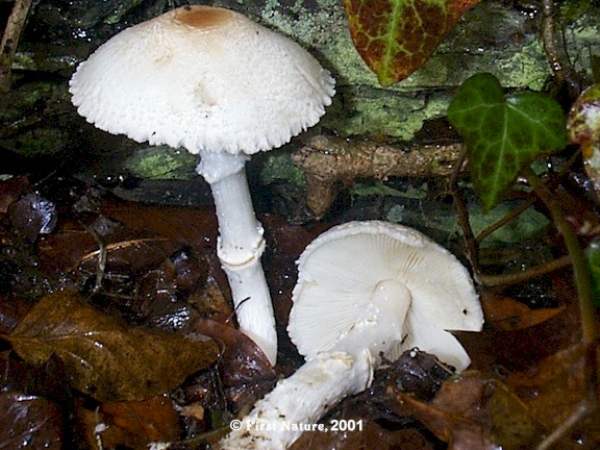
Lepiota ignivolvata is an occasional species in
most kinds of woodland. It is most common in areas of chalk or
limestone, where it first occurs in late summer and autumn; however, the conifer forests of West Wales also contain plenty of these distinctive dapperlings.
These rather stately dapperlings (dapper might be a better word!) are instantly recognisable by the orange-banded double rings low down on the stems.
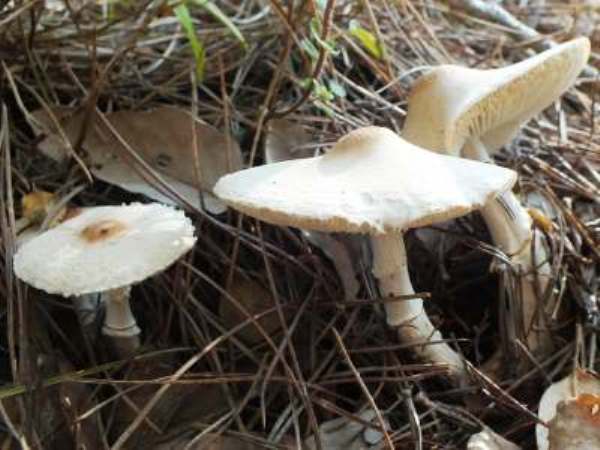
Distribution
Quite a rare find in Britain and Ireland, this dapperling mushroom is much more common in central and southern mainland Europe. As far as I can determine, Lepiota ignivolvata has not been recorded in North America.
Taxonomic history
The basionym of this species dates from as recently as 1948, when French mycologists M. Bousset and Marcel Josserand (1900 - 1992) described this dapperling and gave it the binomial scientific name Lepiota ignivolvata by which it is still generally known today.
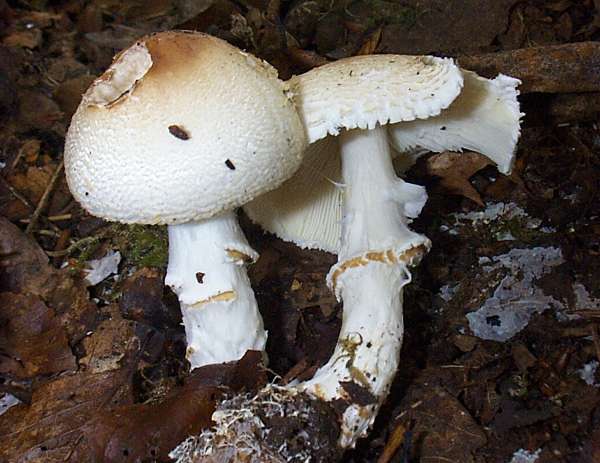
Etymology
Lepiota, the genus name, comes from the Latin word lepis, meaning scale, and is a reference to the scaly surfaces of caps of members of this group of agarics.
The specific epithet ignivolvata means 'wrapped with fire' - a reference to the orange (flame-coloured) band in the centre of the stem ring. (This mushroom is referred to as the Orange-girdled Dapperling in some field guides.)
Toxicity
Until recently, dapperlings were more commonly referred to in Britain as parasols - a potential source of confusion that may have added to the incidence of poisoning, as the large Macrolepiota species (commonly known as parasols) are good edible mushrooms. Lepiota ignivolvata, like most if not all small woodland dapperlings, is regarded by many authorities as at least suspect and possibly a seriously poisonous mushroom, and so great care is essential to avoid accidentally including it when gathering mushrooms to eat.
Identification guide
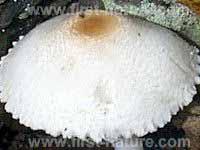 ; ; |
Cap
4 to 10cm in diameter, the delicate cap of
this whitish dapperling mushroom has light tan scales, more crowded and
darker towards the centre.
The cap flesh is creamy-white and very soft. |
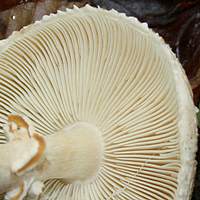 |
Gills
The free, crowded gills are white, sometimes
becoming cream with age. |
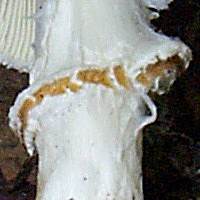 |
Stem
A distinctive feature of this parasol
mushroom is the bold red-brown or orange banded double ring fairly low down on the
stem.
The stem itself is white and smooth or finely scaly; it is parallel
with a diameter of 0.6 to 1.5cm. |
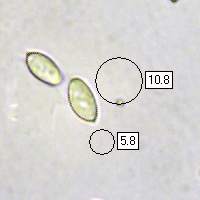 |
Spores
Ellipsoidal, smooth, 9-12 x 5-6µm; dextrinoid.
Spore print
White. |
Odour/taste |
Smell reminiscent of rubber, and an
unpleasant rancid taste. |
Habitat & Ecological role |
On soil under conifers and broad-leaf trees. |
Season |
August to November in Britain and Ireland. |
Similar species |
The much more common Stinking Dapperling, Lepiota
cristata looks and smells very similar, but it lacks the
distinctive red-brown ring mark. |

Reference Sources
Fascinated by Fungi, 2nd Edition, Pat O'Reilly 2016, reprinted by Coch-y-bonddu Books in 2022.
Funga Nordica: 2nd edition 2012. Edited by Knudsen, H. & Vesterholt, J. ISBN 9788798396130
British Mycological Society. English Names for Fungi
Dictionary of the Fungi; Paul M. Kirk, Paul F. Cannon, David W. Minter and J. A. Stalpers; CABI, 2008
Taxonomic history and synonym information on these pages is drawn from many sources but in particular from the British Mycological Society's GB Checklist of Fungi.
Acknowledgements
This page includes pictures kindly contributed by Simon Harding.
Top of page...
Fascinated by Fungi. Back by popular demand, Pat O'Reilly's best-selling 450-page hardback book is available now. The latest second edition was republished with a sparkling new cover design in September 2022 by Coch-y-Bonddu Books. Full details and copies are available from the publisher's online bookshop...